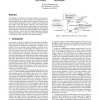Free Online Productivity Tools
i2Speak
i2Symbol
i2OCR
iTex2Img
iWeb2Print
iWeb2Shot
i2Type
iPdf2Split
iPdf2Merge
i2Bopomofo
i2Arabic
i2Style
i2Image
i2PDF
iLatex2Rtf
Sci2ools
85
Voted
ICCAD
1998
IEEE
1998
IEEE
Tight integration of combinational verification methods
Combinational verification is an important piece of most equivalence checking tools. In the recent past, many combinational verification algorithms have appeared in the literature. Previous results show that these algorithms are able to exploit circuit similarity to successfully verify large designs. However, none of these strategies seems to work when the two input designs are not equivalent. We present our combinational verification algorithm, with evidence, that is designed to be robust for both the positive and the negative problem instances. We also show that a tight integration of different verification techniques, as opposed to a coarse integration of different algorithm, is more effective at solving hard instances.
Combinational Verification | Combinational Verification Algorithm | Equivalence Checking Tools | Hardware | ICCAD 1998 |
Related Content
| Added | 04 Aug 2010 |
| Updated | 04 Aug 2010 |
| Type | Conference |
| Year | 1998 |
| Where | ICCAD |
| Authors | Jerry R. Burch, Vigyan Singhal |
Comments (0)

